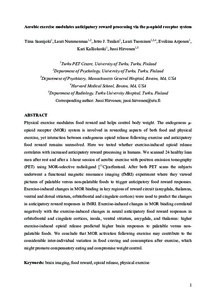Aerobic exercise modulates anticipatory reward processing via the mu-opioid receptor system
Tiina Saanijoki; Jussi Hirvonen; Kari K. Kalliokoski; Jetro J. Tuulari; Eveliina Arponen; Lauri Tuominen; Lauri Nummenmaa
Aerobic exercise modulates anticipatory reward processing via the mu-opioid receptor system
Tiina Saanijoki
Jussi Hirvonen
Kari K. Kalliokoski
Jetro J. Tuulari
Eveliina Arponen
Lauri Tuominen
Lauri Nummenmaa
WILEY
Julkaisun pysyvä osoite on:
https://urn.fi/URN:NBN:fi-fe2021042719740
https://urn.fi/URN:NBN:fi-fe2021042719740
Tiivistelmä
Physical exercise modulates food reward and helps control body weight. The endogenous mu-opioid receptor (MOR) system is involved in rewarding aspects of both food and physical exercise, yet interaction between endogenous opioid release following exercise and anticipatory food reward remains unresolved. Here we tested whether exercise-induced opioid release correlates with increased anticipatory reward processing in humans. We scanned 24 healthy lean men after rest and after a 1 h session of aerobic exercise with positron emission tomography (PET) using MOR-selective radioligand [C-11]carfentanil. After both PET scans, the subjects underwent a functional magnetic resonance imaging (fMRI) experiment where they viewed pictures of palatable versus nonpalatable foods to trigger anticipatory food reward responses. Exercise-induced changes in MOR binding in key regions of reward circuit (amygdala, thalamus, ventral and dorsal striatum, and orbitofrontal and cingulate cortices) were used to predict the changes in anticipatory reward responses in fMRI. Exercise-induced changes in MOR binding correlated negatively with the exercise-induced changes in neural anticipatory food reward responses in orbitofrontal and cingulate cortices, insula, ventral striatum, amygdala, and thalamus: higher exercise-induced opioid release predicted higher brain responses to palatable versus nonpalatable foods. We conclude that MOR activation following exercise may contribute to the considerable interindividual variation in food craving and consumption after exercise, which might promote compensatory eating and compromise weight control.
Kokoelmat
- Rinnakkaistallenteet [19250]
